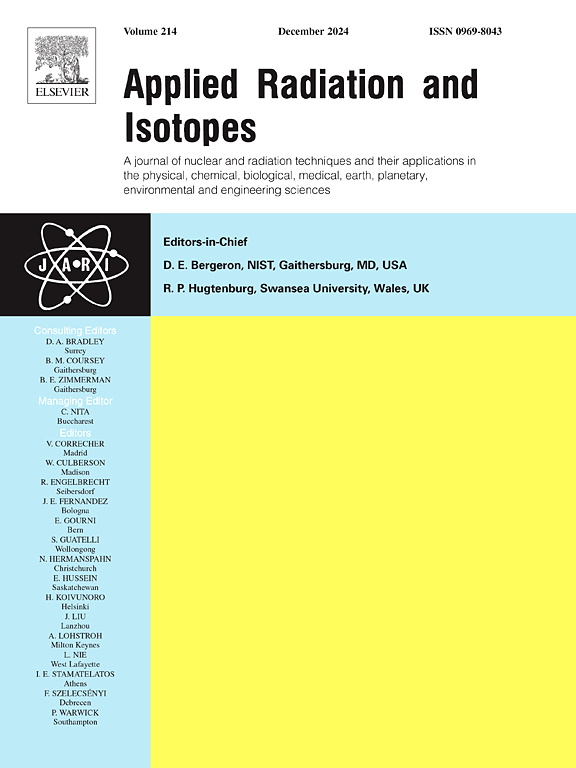Measurement of the 10B(d,n)11C reaction cross-section in the energy range of 0.05–0.57 MeV in inverse kinematics
IF 1.6
3区 工程技术
Q3 CHEMISTRY, INORGANIC & NUCLEAR
引用次数: 0
Abstract
The excitation function for the 10B(d,n)11C reaction was measured in the energy range of 0.05–0.57 MeV. The measurements were performed using the inverse kinematic reaction 2H(10B,n)11C to reduce the background specific to the experiments with deuteron beams and to prevent the leakage of 11C recoil nuclei from the target. Two scintillation detectors based on NaI(Tl) crystals operating in coincidence mode were used to detect γ-rays with an energy of 0.511 MeV produced during the β+ decay of 11C. The cross-section of the 2H(10B,n)11C reaction was obtained from the analysis of the decay curve of 11C after irradiation taking into account the detection efficiency of the system, the concentration of deuterium atoms in the target and the stopping power for boron ions. Then the cross-section of the 10B(d,n)11C reaction was calculated using known kinematic equations. The obtained cross-section data are generally in agreement with the data previously reported for deuteron energies less than 0.2 MeV and are inconsistent with the data corresponding to energies greater than 0.5 MeV. The experimental data in the energy range of 0.2–0.5 MeV were obtained for the first time.
在0.05-0.57 MeV能量范围内10B(d,n)11C反应截面的逆运动学测量
10B(d,n)11C反应的激发函数在0.05 ~ 0.57 MeV的能量范围内测量。采用逆运动学反应2H(10B,n)11C进行测量,以减少氘束实验的背景特异性,并防止11C反冲核从目标中泄漏。利用两台工作在符合模式下的NaI(Tl)晶体闪烁探测器,对11C β+衰变过程中产生的能量为0.511 MeV的γ射线进行了探测。考虑体系的探测效率、靶体中氘原子的浓度和对硼离子的阻止能力,通过对辐照后11C衰变曲线的分析得到了2H(10B,n)11C反应的截面。然后利用已知的运动学方程计算了10B(d,n)11C反应的截面。所得截面数据与先前报道的氘核能量小于0.2 MeV的数据基本一致,与能量大于0.5 MeV的数据不一致。首次获得了0.2 ~ 0.5 MeV能量范围内的实验数据。
本文章由计算机程序翻译,如有差异,请以英文原文为准。
求助全文
约1分钟内获得全文
求助全文
来源期刊

Applied Radiation and Isotopes
工程技术-核科学技术
CiteScore
3.00
自引率
12.50%
发文量
406
审稿时长
13.5 months
期刊介绍:
Applied Radiation and Isotopes provides a high quality medium for the publication of substantial, original and scientific and technological papers on the development and peaceful application of nuclear, radiation and radionuclide techniques in chemistry, physics, biochemistry, biology, medicine, security, engineering and in the earth, planetary and environmental sciences, all including dosimetry. Nuclear techniques are defined in the broadest sense and both experimental and theoretical papers are welcome. They include the development and use of α- and β-particles, X-rays and γ-rays, neutrons and other nuclear particles and radiations from all sources, including radionuclides, synchrotron sources, cyclotrons and reactors and from the natural environment.
The journal aims to publish papers with significance to an international audience, containing substantial novelty and scientific impact. The Editors reserve the rights to reject, with or without external review, papers that do not meet these criteria.
Papers dealing with radiation processing, i.e., where radiation is used to bring about a biological, chemical or physical change in a material, should be directed to our sister journal Radiation Physics and Chemistry.
 求助内容:
求助内容: 应助结果提醒方式:
应助结果提醒方式:


